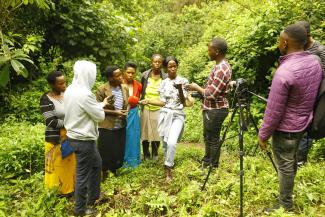The media plays a crucial role in educating the public. To increase the regional journalists' awareness on how East Africa’s most iconic wildlife and habitats are inextricably linked to its people’s survival and well-being, a trip was organized to the Albertine region in Uganda, the Maasai Mara in Kenya, and Mkomazi in Uganda for 20 regional journalists.
“This trip has allowed us to appreciate the value of our transboundary resources. We will make every effort to increase coverage of the success in biodiversity conservation as well as highlight challenges to the public," said Franklin Draku, a journalist with the Daily Monitor in Uganda.
The journalists learned about the value of transboundary natural resources and interviewed community members, environmental experts, and government officials. After the trip, they published over 20 stories across multiple media and contributed to promote the need to develop ways of recognizing and increasing the value of wildlife and natural capital for public audiences.
“This trip and discussions that followed have opened our eyes to areas of collaboration across different media houses. We have seen the need to work together to enable the public to understand conservation problems, techniques to address them and their role in addressing them,” Joyce Shebe from Tanzania’s Cloud Media.
Their stories covered topics like sustainable community conservation models, role of communities in reducing wildlife crime, the value of nature in mitigating climate change, and the impact of human activities on transborder wildlife corridors among others. Each story aims to increase public awareness and public willingness to protect nature.
“We have a role to play in getting the public and various stakeholders to appreciate the value of nature and conserve it,” said Aghan Daniel, a journalist from Kenya.
Links for more:
Maasai Mara herders find innovative way to keep hungry lions at bay
The benefits of involving local communities and women in conservation efforts
How Mother Nature can get Africans away from shocks brought by climate change
How community coffee tourism is reducing pressure on Rwenzori Mountains National Park
Conserving the Environment: Sustainable Frontier Community Livelihoods model

CONNECT/IUCN
